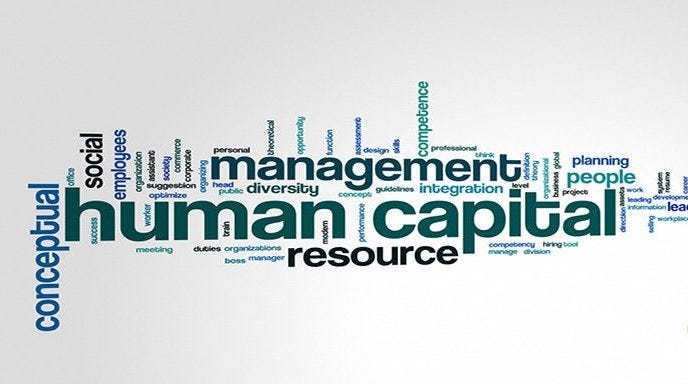
Interviewer: Aco Momcilović, psychologist, EMBA, Owner of FutureHR

This paper attempts to answer questions such as: What is human capital, and what does it consist of? How can human capital be assessed, and what are the differences between countries? Problems that countries face when they do not have a human capital coherent with development needs and how to solve them. The ratio of human capital and the speed of development in some critical areas of new technologies. How much do entrepreneurs invest in human capital?
Human Capital subject is foundation for NAIC (National AI Capital) concept I proposed here: https://medium.com/@acomomcilovic/introducing-concept-national-ai-capital-a233832796c1
Human capital development
Human capital and its awareness have been increasing for several decades, becoming increasingly important in recent years. People and their abilities become the most crucial resource of any organization. The concept of human capital and its appearance is associated with Adam Smith — 18th-century economist and philosopher. However, there are different definitions and divisions of types of human capital. In a business environment, it can be seen as abilities, knowledge, and skills that have an economic value, increasing a person’s productive abilities. The OECD defines human capital broadly as “the knowledge, skill, competence, and traits of people that contribute to the creation of personal, social, and economic well-being.” In the development of human capital, both employers and employees make significant investments. Thus, the area is closely related to the area (and departments) of human resources.
Except on a personal level, of course, we can also measure productivity on a national level. In one of the first studies, Denison came up with data that investment in human capital can be associated with more than 40% of national income growth.
Human capital’s very concept accentuates that people’s contribution to organizations is more than just physical work. This relationship of contribution levels has changed over time, from primarily physical work to today’s jobs. That contribution is the smallest, and the most significant added value is provided through intellectual, creative, and other abilities.
1. Correlation with the intellectual capital
Depending on a theoretical approach related to intellectual capital (often as a subtype of it) that can also be divided into two forms, human capital is:
1. Material in the form of plans, projects, patents, licenses, databases, manuals,
rules of procedures, corporation standards, computer programs.
2. Immaterial, which is in the minds of employees (knowledge, visions, ability to act,
problem-solving, leadership, culture, experience), in the literature referred to as the hidden knowledge (Tacit Knowledge).
One of the possible divisions is the division into three types of human capital:
1. intellectual capital consisting of specialized knowledge, implicit knowledge, cognitive complexity, and learning ability;
2. societal/social capital consisting of a network of relationships, sociability, trustworthiness, and trust that we have created through relationships;
3. emotional capital consisting of self-confidence, ambition and courage, ability and resilience.
As various studies have shown at the global level, human capital can also be controlled at higher levels than organizational units. Especially interesting are the comparisons of countries on the issue of human capital assessment. Because of human capital theory, which assumes that investments can be quantified, different countries choose different strategies to maximize results. For example, some countries will allow free education for their citizens because more educated people earn more and therefore spend more money, which positively impacts the entire economy.
To highlight the importance of resources invested in the education and health of residents (which at the country level directly affect human capital), the World Bank has launched the Human Capital Index Map, through which it tracks prosperity and quality of life in countries of the world. A vital warning was given by Jim Yong Kim, President of the World Bank, in 2018 when he said: “Our analyses suggest that the countries with the lowest investment in human capital today will have a future workforce of only a third to half of the productivity compared to the labor force of countries that have a high investment in human capital today.”
Professionals working on the topic of human capital are in an unenviable position: they have to deal with the unequal speed of the development of the world economy, the explosion of local, national, and international regulations, changes due to the technological revolution, new and unpredictable sources of competition, and the geographical imbalance between people with the necessary skills and locations where jobs with these skills are required. McKinsey has explored the opportunities opening up in the area, and listed the following as some of them:
1. Anticipation and planning for what human capital will look like in the future: how many changes will be associated with the millennial generation’s connection and the development of virtual offices’ accelerated development during the Covid-19 pandemic. Organizational design and workforce flexibility will undoubtedly influence the use of human capital.
2. Ensuring the flexibility of human capital: preparing the workforce for constant and rapid changes.

2. Changes in demand
A good illustration of how quickly human capital is becoming important is shown by the US Bureau of Statistics analysis of numbers (from 2012) from which you can see that:
1. the number of jobs with complex problem solving increased by 4.8 million;
2. the number of jobs in production (converting materials into finished products) decreased by 0.7 million;
3. the number of jobs that are transactional and can be automated decreased by 2.7 million.
It is also interesting to see in what business segments we will note the reduction in numbers. Industries that will lose most people are the following:
- production
- administration and support
- retail, construction, and
- finance, and insurance
Furthermore, those that will have the most of new jobs will be.
- health
- educational services and
- civil services.

3. Comparison by country
It is also interesting to compare the Human Capital Index by country, operated by the World Economic Forum (WEF). According to WEF, Croatia is in a stable 37th place. The top 10 countries in 2017 were: Norway, Finland, Switzerland, the United States, Denmark, Germany, New Zealand, Sweden, and our neighbors Slovenia and Austria.
Looking at regions globally, North America and Western Europe stand best with more than 70% of realized capacity. The worst are Sub-Saharan Africa and South Asia, with less than 60%. Of course, in each of these regions, some countries are significantly above or below average and can serve as good (bad) examples.
Some countries can be good examples for the clear presentation of the problematics. An exciting example of the difficulties associated with human capital is the 34th country on the WEF list, China. With changing dynamics in economic, social, and demographic terms, it may be best to precisely see how human capital issues will decide the country’s future. From one that is economically focused on investment to a new one that is focused on consumption, the evolution of China will involve a change from a low-cost labor model that creates low-cost products to a service-oriented one that will require a large number of workers with higher skill levels. That trend has been felt over the past ten years. It also has positive consequences for businesses — a more considerable number of wealthier workers, and negative ones for businesses — the lack of a sufficiently educated workforce for new jobs to perform.
A particular theme that is becoming more prominent in China, Croatia, and many other countries, is precisely the fit of human capital and market needs. Employer surveys continuously show that they are dissatisfied with young people’s skills and knowledge, leaving the education system. Creating a modern and usable human capital will require significant adjustments to the educational curriculums. It is not once that this would be needed, and we should create a habit of faster, continuous adaptation to the needs that will contribute to technological progress.
For their part, businesses will have to respond to these shortcomings in different ways: from working with young people in schools and colleges to creating their boot camps, inevitably collaborating with their competitors, and so on.

4. The development of artificial intelligence
After selecting the definition and subtypes of human capital, comparing countries, and examples of problems, the topic will also be considered through the prism of developing one well-defined business area. One of the possible multipliers of efficiency at the level of enterprises and countries will be a success in the development of artificial intelligence. Both the US and China are actively investing in developing these technologies, and all countries that start to lag may find themselves in a very awkward position. There are very few unicorn startups in Europe (a surge of more than the US $ 1 billion), and it does not have any of the top 10 businesses. Although it is one of the first to start developing and researching artificial intelligence, the level of investment is significantly lower than that of its main competitors. In 2018 China attracted almost 50% of all investments in artificial intelligence, and the US another 38%, which led to the fact that Europe is a thing of the past. The European Commission has announced an investment of £ 2.6 billion in artificial intelligence and robotics development. For comparison, China has invested £ 1.9 billion in only one technology Park (in Beijing).
Fortunately for Europe, the level of investment is just one contribution that is important for developing new projects or startups. The second is precisely human capital. If we compare the number of software engineers, more of them are in Europe, or 5.7 million, compared to the United States, which has 4.4 million. The success associated with human capital use depends on both the number and density of different technological hubs. Thus, good communication and partnership between private enterprises and universities are essential for artificial intelligence. At the strategic level, some cities or states focus on precisely defined areas where they create demand for this type of product (for example, Helsinki is focused on the biotech and gaming industries) and develop human capital in some niches.
According to a 2019 Deloitte study, one of the trends is creating an entirely new business — the vast majority of organizations said they expect to increase or significantly increase the use of AI, cognitive technologies, robotic process automation, and robotics in the next three years. While organizations embrace technology, every business also needs to change because the future is more digital, multidisciplinary, and more data-oriented. Paradoxically, to take full advantage of technology, an organization must redesign workplaces to focus on finding the human dimensions of working in them. That will create new roles that we call “super jobs*”: jobs that combine parts of various traditional jobs into integrated roles that affect the significant productivity and efficiency that can occur when people work with technology.
The importance of tracking changes
It should also be remembered that skills that were useful and in demand, due to constant changes in the environment, can quickly become outdated. Thus, continuous investment in new knowledge and adaptability skills becomes an essential component of human capital value.
Then there is a much broader theme of country branding that, if well done, will attract the best professionals from all corners of the world or early-stage students who can study at local colleges. Given the excellent quality of some Croatian faculties, it would be a shame not to take advantage of the opportunities to increase the human capital that Croatia is facing.
To conclude, Nikola Tesla’s quote that talks about the importance and diversity of the human capital factor:
“The practical success of an idea, regardless of its inherent capabilities, depends on the attitude of contemporaries.”
Appendix 1 — Definition: Superjobs — roles that combine work and responsibilities from more traditional jobs, using technology to increase and expand the scope of work performed, and include a more complex set of domains, technical, and human skills.
Appendix 2 — Examples from Croatia: results of short surveys conducted by the Glas Poduzetnika Association show that more than 40% of them do not receive any education at all or very little. Besides, more than 40% do not spend money on education because they make an effort to study online, and another 11% do not have any or have a minimal budget for training.
Literature:
McKinsey & Co (2012) State of Human Capital
McKinsey & Co (2013) The $250 billion question — Can China close the skills gap?
McKinsey Global Institute (2019) How to develop enough European AI startups
WEF (2017) The Global Human Capital Report
World Bank (2018) Methodology for a World Bank Human Capital Index
2019 Deloitte Global Human Capital Trends
CIPD: Technical Report 2017 — Human capital theory

